The Future of Warehousing – Trends Shaping The Industry
Author: Scotty Lee, Content Marketing Manager, Seagull Scientific
Quick Overview:
- Warehousing is continuing to grow strongly, particularly with the explosive growth of online shopping.
- The sector faces challenges with consumers demanding rapid shipping, continuing labor shortages, rising land costs, and the drive for sustainability.
- Technology can help address warehousing challenges – including automation, centralized Warehouse Management Systems (WMS) systems, the Internet of Things (IoT) and smart labeling.

Warehousing is an essential element of the supply chain – the invisible ‘middle man’ between the manufacturers who make the goods we buy and the retail operations through which we make our purchases.
Warehousing is a large business – globally the market was worth over $691 billion (USD) in 2023, with a growth rate of 6.86% that is projected to expand to $963 billion by 2028. Warehousing has undergone some significant changes in the last few years, particularly since the pandemic. The key trends that are driving these shifts include:
- eCommerce – online shopping grew by a dramatic 55% during the pandemic and it’s a continuing trend. Online shopping means that instead of simply sending bulk orders to stores, warehouses must pick individual orders too, significantly increasing the picking workload.
- Rapid shipping – at the same time as online shopping has grown, so too have customer demands, with shoppers expecting ever faster delivery times. Delivery speed carries high stakes, since 69% of shoppers say that fast delivery increases their likelihood of buying. This of course places pressure on warehouses to get the goods off the shelves as quickly as possible.
- Visibility – it’s not just speed that customers demand, they also want visibility. Customers expect shipping notifications throughout the process – when the order is confirmed, when the goods are picked, shipped, in transit, and delivered. To meet this requirement, warehouses must be able to track individual orders.
- Omnichannel warehousing – increasingly, retail operators are moving to a having a single inventory pool for all goods, for stores, for online orders, and for returns. These consolidated warehouses are bigger and must be able to manage items for different parts of the retail operation.
- Labor constraints – warehousing is still a relatively labor-intensive industry and has been hit hard by a shortage of workers in recent years. In the UK, for example, a survey found that more than 80% of organizations were experiencing a shortage of warehouse staff.
- Availability of physical warehouse space – warehouses require a lot of space, and the price of land, construction materials, and labor have increased in many countries. With all of the rising costs, it is no wonder that it is becoming more costly to develop new warehousing facilities.
- Sustainability – the global drive towards greater sustainability means that warehouses are striving to use less energy overall and move to sustainable energy sources.
Technologies Addressing the Trends
Warehouse operators are turning to technology and digitization to address these industry changes including:
- Warehouse automation – warehouses are looking to optimize their operations using Artificial Intelligence (AI) and robotics. For example, AI can optimize storage layouts to get the most from every inch of shelf space and can pick routes for maximum productivity. Robots can be used for automated put away and automated guided vehicles (AGVs) are increasingly being used for moving goods around the warehouse. Collaborative robots, or ‘co-bots’ are specifically designed to work alongside humans and can enhance the efficiency and safety of their human co-workers.
- Warehouse Management Systems (WMS) and data intelligence software – warehouse operators are increasingly turning to centralized cloud-based WMS systems. This ensures that every part of the warehouse works from and updates a ‘single source of the truth’, eliminating data anomalies and increasing efficiency. Warehouse management systems can also link to external data (from suppliers and retailers for example) and with other internal systems, such as label management software, ensuring that all information is accurate and aligned.
- RFID – this technology (Radio Frequency Identification) allows items and goods to be tracked without having to be individually scanned. The RFID tag emits a signal that can be read, even when the goods are not within line of sight, and multiple tags can be read at any one time. RFID enables automated goods receipt and efficient item tracking through every stage of the warehousing process.
- Internet of Things (IoT) – connected smart devices and sensors collect and provide data to drive warehouse efficiencies. For example, sensors can monitor and report on temperature and humidity, essential for the safe storage of certain goods. Smart shelving can capture and send inventory information, including alerts about low stock or misplaced products.
- Wearables – helping pickers be more productive is one of the greatest gains for a warehouse and wearable technology helps achieve this. Warehouses are implementing voice-based picking lists, which speak the order to the picker via a headset, and augmented reality smart glasses, where the picker can see the list in front of their eyes. These systems save the picker having to constantly refer to a written list on paper or a tablet and can significantly speed up the picking operation.
- Smart labeling solutions – the key to tracking and visibility is labeling. Labeling of goods, but also labeling of shelves and storage locations. Warehouses are increasingly taking advantage of the benefits of smart labeling solutions, integrated with their WMS, to streamline the process of designing and printing high quality labels and RFID tags that enable fast and efficient tracking and tracing.
Warehousing is the very heart of the supply chain and is undergoing a transformational shift towards digitization and modernization to create the efficiencies needed to keep up with the increasing demands of the market.